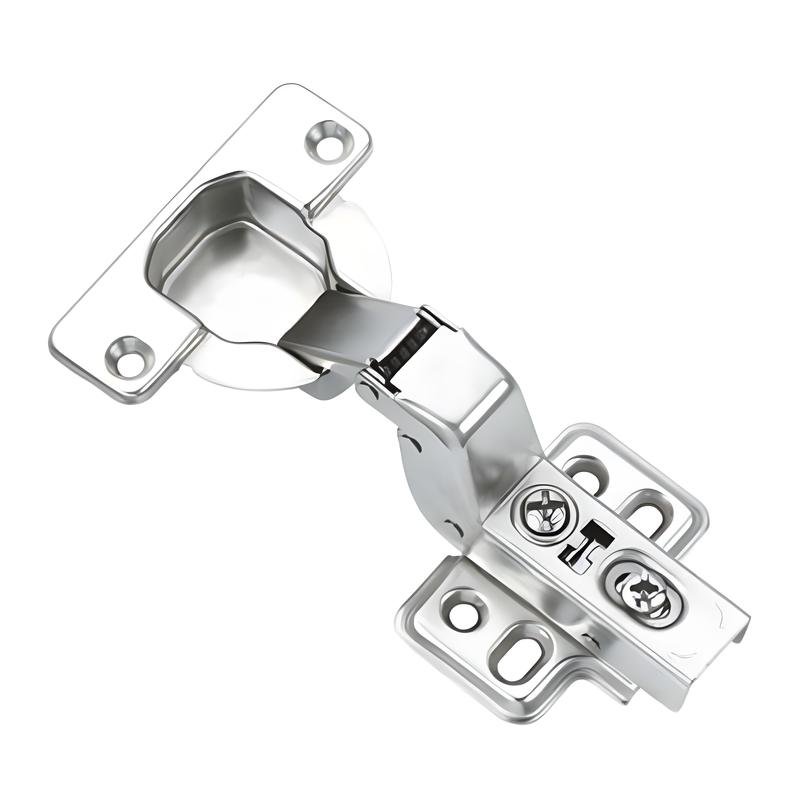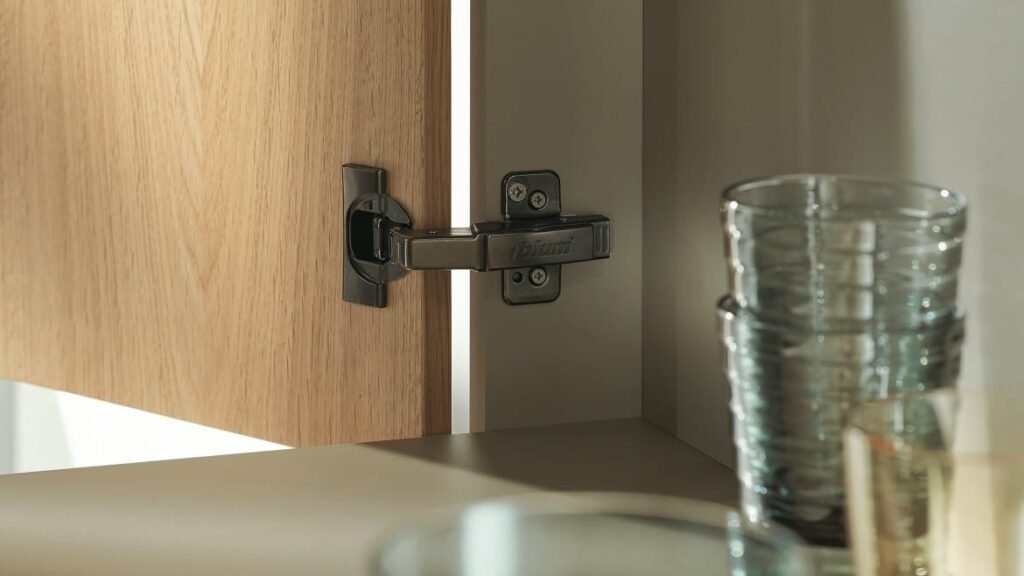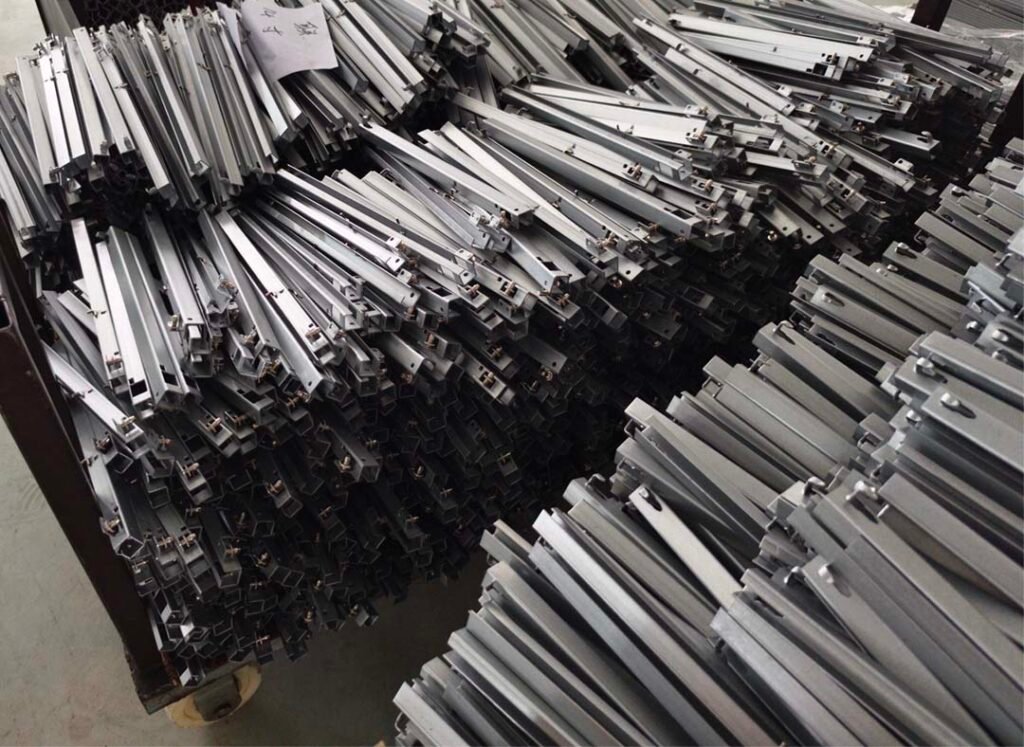
ø40 Fixed Soft Close Concealed Door Hinges - KF207
Inset(C=23)
Main Material: Cold-rolled steel/Q235
Finish: Nickel Plated
Opening hinge: 95°
Dia. of hinge cup: 40mm
Depth of hinge cup: 13mm
Product thickness: 1.0mm
Door (K) dimension: 3-11mm
Door thickness: 20-28mm
Application Segment
Cabinet Doors, Wardrobe Doors


Our Services

MOQ Offered
We provide flexible minimum order quantities, allowing you to start small and scale up as needed.

Large Inventory
Ensuring Ample Stock for Immediate Shipment, Eliminating Wait Times for Production.

Complete Specifications
We refine various specifications of hinges according to different usage scenarios.
AOLISHENG manufactures concealed door hinges that meet standards, offering customized services and solutions to help your business succeed.
Why Choose AOLISHENG
Rich Experience
With years of concealed door hinges production experience, we have a team of professionals specializing in hinge design, manufacturing, and management.
Leading Production Capacity
We possess CNC machining for heavy-duty applications, wire-cutting machines, automated balancing, pressing equipment, and electroplating production lines for hinge manufacturing.
Quality Assurance
All hinges undergo over 48 hours of salt spray testing and are subjected to more than 80,000 cycles of open-close testing with appropriate door weights, meeting the quality standards of QB/T2189-1995.
Mass Production Capability
With over 10,000 square meters of production facilities and thousands of square meters dedicated to electroplating workshops, we ensure a large-scale supply of hinges.
We Look Forward To Your Contact
AOLISHENG is your trusted global partner for high-quality drawer slide and hinges production, with strategic factories worldwide and professional local service teams. Partnering with AOLISHENG ensures efficient project delivery, robust supply chains, expert technical support, and a thriving customer base.
FAQ
What holds glass in place in door?
The fixing of glass in the door mainly relies on the following methods and components to keep it stable:
1. Clamps
Fixing design: Clamps are components specially designed to fix glass, usually by clamping on the edge of the glass.
Material: Clamps are usually made of metal (such as stainless steel) or plastic, which can provide stable support and reduce pressure on the glass.
2. Hinges
Glass hinges: Hinges used to support and rotate glass doors usually have a clamping design, which is directly clamped on the edge of the glass to ensure the stability of the door.
Type: Including hidden hinges, clamping hinges adjustable hinges, etc., selected according to installation requirements.
3. Adhesives
Structural adhesives: High-strength structural adhesives (such as epoxy resin) can be used to fix glass to the door frame, especially in the absence of clamps.
Transparent adhesives: Used for fixing and sealing small areas to maintain beauty and functionality.
4. Frames
Door frame design: Many glass doors adopt a frame design, with the glass embedded in the frame, and the structure of the frame supports and fixes the glass.
Sealing strips: Sealing strips are often used inside the frame to ensure a tight fit of the glass and prevent air and moisture penetration.
5. Gaskets
Gaskets: Gaskets are installed between the glass and the door frame to help cushion and secure the glass while preventing vibration and wear.
Material: Usually made of rubber or foam, providing soft support and sealing.
6. Silicone or Sealant
Sealing and fixing: Used to fill the gap between the glass and the door frame, providing additional fixing and waterproofing.
Application: Usually used in areas that require waterproofing or additional fixing.
Summary
Fixing glass in doors mainly relies on components and methods such as clamps, hinges, adhesives, frames, gaskets, and silicone. These elements ensure that the glass door is firm, stable, and safe while providing smooth operation and good sealing performance.
What are the 5 different types of hinges?
Five common hinge types are used for different doors and applications. Here is a brief introduction to each type:
1. Hinges
Standard hinges (Butt hinges): The most common type of hinge, usually used for interior and exterior doors. It consists of two flat plates (leaves) and a pin, suitable for the opening and closing of most doors.
2. Concealed door hinges
Function: Completely hidden between the door and the door frame when installed, and only visible when the door is open. Provides a clean, modern look.
Application: Commonly used for modern interior doors, cabinet doors, etc.
3. Continuous hinges
Function: Also known as “continuous hinges”, there is a continuous hinge body throughout the height of the door. Provides uniform support and is suitable for heavy doors.
Application: Mostly used for industrial or heavy doors, such as commercial gates and warehouse doors.
4. Spring hinges
Function: Built-in springs enable the door to close automatically. The tension of the spring can be adjusted to control the closing speed.
Application: Commonly used for interior doors and office doors, especially where the door needs to close automatically.
5. Sliding Door Hinges
Function: A system for sliding doors that allows the door to slide smoothly on a track instead of rotating around an axis.
Application: Commonly used in sliding doors, glass doors, storage doors, etc.
Summary
These five hinge types are suitable for different needs and application scenarios. Standard hinges are suitable for general doors, concealed door hinges provide a modern appearance, hinges are suitable for heavy doors, spring hinges are used for automatic closing needs, and sliding hinges are used for sliding door systems. Choose the appropriate hinge type according to the use needs and design requirements of the door.
How thick does a cabinet door need to be for concealed hinges?
For concealed door hinges, the thickness of the cabinet door usually needs to meet certain standards to ensure that the concealed door hinges can be installed correctly and provide the required function. Here are some guidelines for cabinet door thickness:
1. Standard door thickness
Common thickness: Most concealed door hinges are designed for cabinet doors with a thickness between 18 mm (about 3/4 inch) and 25 mm (about 1 inch). These thicknesses ensure that the concealed door hinges work properly and support the weight of the door.
2. Special needs
Thinner doors: If the thickness of the cabinet door is less than 18 mm (such as 15 mm), you need to ensure that the concealed door hinges you choose are suitable for thinner doors and adjusted according to the manufacturer’s specifications.
Thicker doors: For doors thicker than 25 mm, specially designed concealed door hinges or additional adjustment accessories may be required to ensure correct installation and function.
3. Influencing factors
The weight of the door: Thicker doors can usually withstand more weight, so the thickness of the door should match the weight of the door.
Hinge type: When choosing a concealed door hinge, make sure the design and specifications of the concealed door hinges are suitable for the thickness of the door. Different types and brands of concealed door hinges may have different thickness requirements.
4. Installation Notes
Hinge installation: Concealed door hinges require appropriate grooves to be cut on the door and door frame, and the thickness of the door should meet the installation requirements of the hinge to ensure accurate and stable installation.
Alignment: Make sure the thickness of the door is within the adjustable range of the hinge for proper alignment and adjustment.
Summary
For concealed door hinges, the thickness of the cabinet door should generally be between 18 mm and 25 mm to ensure correct installation and function. If the door thickness exceeds or falls below this range, it may be necessary to select concealed door hinges adapted to doors of different thicknesses or make additional adjustments. Please refer to the recommendations and specifications of the specific hinge manufacturer when selecting and installing.
What is the depth of a concealed hinge?
The depth of the concealed door hinges refers to the depth of the door and door frame groove required for the hinge to be installed. Here is the relevant information:
1. Standard Depth
Common Depth: Most concealed door hinges require a groove depth of approximately 12mm to 15mm cut into the door and door frame to accommodate the main part of the hinge.
2. Special Requirements
Different Types: Different types of concealed door hinges may have different depth requirements, depending on the design and brand of the hinge.
Door and Door Frame Thickness: Thicker or thinner doors may require an adjustment in the groove depth to ensure the hinge is properly installed.
3. Installation Notes
Groove Cutting: Make sure the depth of the cut groove matches the specifications of the hinge to ensure that the hinge can be fully embedded in the door and door frame.
Alignment: The accurate groove depth helps the door to align correctly and open and close smoothly.
Summary
The standard groove depth of concealed door hinges is usually 12mm to 15mm, and the specific depth depends on the design and brand of the hinge. When installing, make sure the cutting depth matches the requirements of the hinge to ensure the best installation effect and function.
Do you drill hinges before or after painting?
Drilling before painting is a recommended step. Here are the detailed reasons and steps:
Preparation before drilling
1. Determine the position: Before installing the hinge, you need to accurately mark the position of the hinge on the door frame or door panel. Usually, you can use the template of the hinge itself or manual measurement to determine the position.
2. Drilling: Use a suitable drill bit to drill holes at the marked position. Make sure the depth and diameter of the drilled hole meet the requirements of the hinge so that the hinge can be installed smoothly.
Advantages of drilling before painting
1. Painting consistency: If the drilling is completed before painting, the installation position of the hinge will not be affected by the paint. This ensures the uniformity and consistency of the paint and avoids problems when installing the hinge due to uneven coating thickness.
2. Avoid paint clogging the hole: If the hole is drilled after painting, the paint may enter the hole, causing difficulties in the drilling process or affecting the correct installation of the hinge. When drilling, the paint may crack or fall off due to mechanical force, affecting the appearance and use effect.
3. Reduce hinge installation problems: The painting process may cause a slight impact on the size of the door or door frame. Drilling before painting can ensure that the hinge installation will not be misaligned or difficult to install due to changes in the thickness of the coating.
Painting steps
1. Clean the surface: After drilling, make sure the surface of the door or door frame is clean and dust-free. Cleaning can avoid poor paint adhesion and affect the final painting effect.
2. Protect the hole: After drilling, use appropriate masking materials (such as tape) to protect the hole to prevent paint from entering the hole.
3. Painting: When painting, apply the paint evenly to ensure that the coating is fully covered and remove the protective material after drying.
4. Install the hinge: After the paint is completely dry, install the hinge. At this time, the hinge should be able to be smoothly embedded in the previously drilled hole, and there will be no installation problems due to the thickness of the paint.
In summary, drilling before painting is to ensure the accuracy of the hinge installation and the beauty of the painting’s effect. Through such steps, it is possible to effectively avoid the influence of the thickness of the paint on the hinge installation and ensure the smooth completion of the overall work.
What does overlay mean in concealed hinges?
In the context of concealed door hinges, “overlay” refers to how the door is installed to align with the door frame when closed. Specifically, an overlay installation means that the edge of the door partially or completely covers the door frame. Here is a detailed explanation:
Overlay
1. Definition
Overlay: When a door is installed in an overlay configuration, the door extends beyond the edge of the door frame when closed. This means that the surface of the door partially or completely covers the outside of the door frame when closed.
2. Types of Overlay
Full Overlay: The door completely covers the outer edge of the door frame, and no part of the door frame is visible when the door is closed. This installation is common in modern cabinet designs and interior doors.
Partial Overlay: The door partially covers the door frame, and part of the edge of the door frame is still exposed. This method can keep part of the door frame visible and is suitable for certain design styles.
3. Application
Modern Design: Full overlay doors are often used in modern decoration styles. It provides a clean appearance and seamless visual effect.
Functionality: This installation method can hide irregularities in the door frame and make the overall appearance smoother.
4. Advantages
Aesthetics: Provides a clean, uncluttered look, especially suitable for designs that require a seamless visual effect.
Hide flaws: Can cover irregularities or imperfections in the door frame.
Summary
In concealed door hinges, “overlay” means that the door covers the edge of the door frame when closed, providing a clean look and modern design style. Full overlay doors completely conceal the door frame, while partial overlay doors only partially cover the edge of the door frame. Choosing the right overlay method can be determined by design needs and aesthetic preferences.
Are concealed door hinges good?
Concealed Door Hinges are a good choice in many cases, with the following advantages:
1. Aesthetics
Seamless appearance: Concealed door hinges are hidden inside the door frame and door, making the door look more neat and modern, suitable for minimalist style and high-end design.
2. Space saving
Space saving: The design of concealed door hinges allows the door to open and close without taking up extra space, suitable for small or complex design areas.
3. Functionality
Smooth opening and closing: Provides a smooth opening and closing experience, usually with precision manufacturing technology and good durability.
4. Security
Prevents vandalism: Concealed door hinges are hidden inside the door, reducing the risk of prying the door open and improving security.
5. Maintenance and cleaning
Simplified cleaning: Since the concealed door hinges are hidden, the door edges are easier to clean, and there is no need to worry about dust accumulation on the exposed hinges.
6. Adaptability
Multi-purpose: Suitable for a variety of door types and design needs, such as wooden doors, glass doors, metal doors, etc.
Potential Disadvantages
Installation Complexity: The installation process can be complex, requiring precise cutting and alignment, and usually requires a professional.
Higher Cost: Concealed door hinges generally cost more than standard hinges, especially high-quality models.
Summary
Concealed door hinges offer significant advantages in terms of aesthetics, space savings, functionality, safety, and maintenance. Although they may be more complex to install and cost more, they excel in providing a clean look and high-end design. Considering these advantages and potential disadvantages when choosing a concealed door hinge can help you decide if it’s the right choice for your needs.
